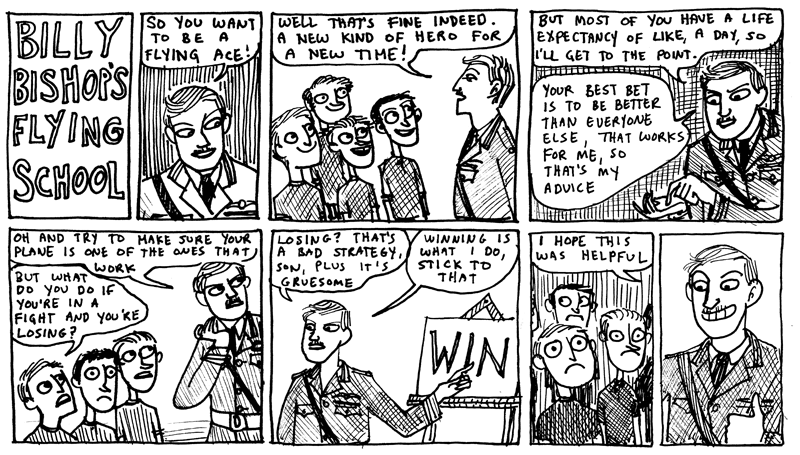

















 buy this print! |
||
Just don't fly during Red April
I'm moved into Halifax but the moving company won't give me my things until next week! So I have no scanner, here is a comic I made a couple weeks ago about Billy Bishop. I find WWI/WWII air combat really interesting, because it was brand new and revolutionary, like how the longbow in the Hundred Years War is interesting. If you look up how the designs of planes rapidly grew stronger during the war (mostly because opposite sides would steal each other's designs and improve on them), you won't be disappointed. As interesting as it is to read, however, you really will find it hard not to be struck by how many lives this new weapon could take, with every 'victory' meaning another plane down. Small numbers compared to ground units, but still. One of my favorite stories that I've told many times has to do with WWII air combat. I used to work in an aviation museum, and one day I was browsing the library when I read about the Guinea Pig Club. It's also the story of plastic surgery. I believe it was in John Keegan's book Soldier, which I wish I had. Flying aces were a big thing at one time, long before Top Gun ruined everything. They were a new kind of hero and they were daring and exciting. We all know who the Red Baron is, every Canadian knows who Billy Bishop is. So if you were a hero, that's great. Heck, it's glamorous. But if you weren't, it could be a totally different story. War had been around since forever by this point, of course. Injured soldiers weren't rare. If you lost an arm or a leg or an eye, people had seen that before. But if you were a pilot who went down, and you lived, your face might have been burnt off. People weren't ready for that. So on one hand you have the glamorous Ace, and on the other, a man who decides that his family should be informed that he died because he figures, it is just as well, he can't bear to let them see him. The surgeon Archibald McIndoe is responsible for a lot of the pioneering treatments for rehabilitating burn injuries, beginning with the injured air crews of the RAF and other Allied forces. His patients at his unit in East Grinstead gave themselves the nickname 'the Guinea Pig Club,' because of the experimental nature of the procedures. But it was a big step, because before this, there was almost nothing for an injury like that. I cannot imagine what it is like to be given your face back. The town of East Grinstead made the wounded pilots welcome, didn't stare, and let them feel like themselves again. The Guinea Pig Club still meets every year, and like the War Amps, they still work with burn victims. I think the story is a wonderful one, because too often- in this case and in many others - history only pays attention to the Aces. |
||
Friends:
Lynn Allingham
John Allison
Dawn and Margie Beaton
Marc Bell
John Campbell
Scott Campbell
Ryan Carley
Anthony Clark
Rebecca Clements
Domitille Collardey
Jillian Comeau, Kim Carson and Michelle Skelding
Aaron Diaz
Jess Fink
Eric Feurstein
Brian Fukushima
Matt Forsythe
Sarah Glidden
Meredith Gran
Lisa Hanawalt
Dustin Harbin
Christopher Hastings
Emily Horne and Joey Comeau
Jon Klassen
Steve Lambke
Hope Larson
Joe List
David Malki
Phil McAndrew
Carolyn Merriman
Carly Monardo
Vicki Nerino
Ryan North
Ryan Pequin
Neil Rough
Jeffrey Rowland
Gabby Schulz
Smart and Bird
Nathan Stapley
Julia Wertz
Britt Wilson
Steve Wolfhard
Chip Zdarsky
Good comic shops that have taught me a thing or two:
The Beguiling, Toronto
Strange Adventures, Halifax
Legends Comics and Books, Victoria
Desert Island, Brooklyn

All content (c)2006-2018 Kate Beaton